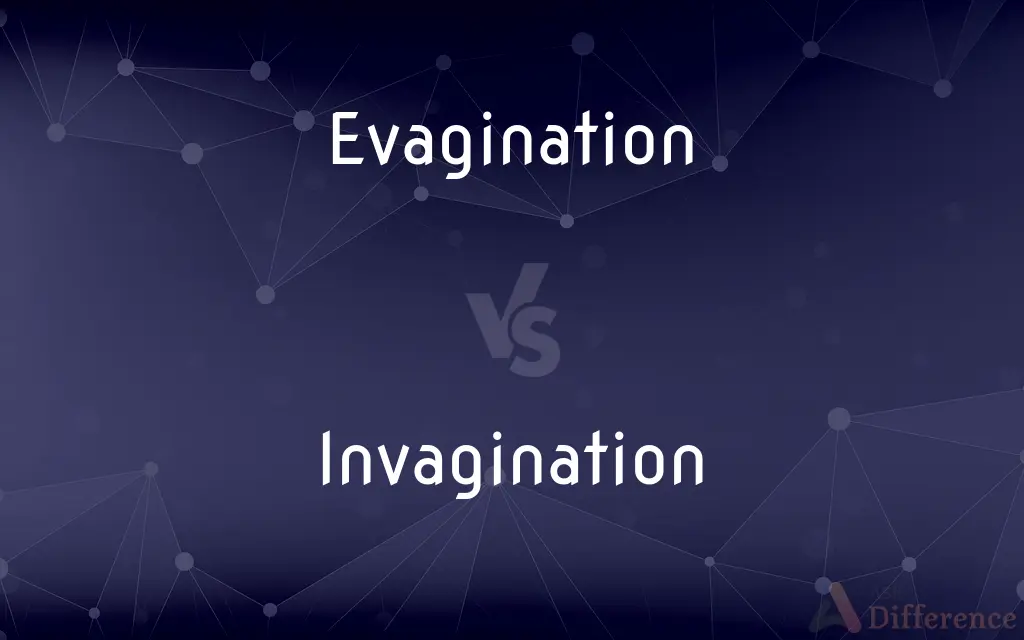Evagination vs. Invagination — What's the Difference?
Edited by Tayyaba Rehman — By Urooj Arif — Updated on March 21, 2024
Evagination involves the outward turning or unfolding of a structure, while invagination is the inward folding or turning of a part.

Difference Between Evagination and Invagination
Table of Contents
ADVERTISEMENT
Key Differences
Evagination is a process where a structure turns outward or unfolds, often observed in biological systems during development or healing. This process can lead to the formation of new structures or the expansion of existing ones. On the other hand, invagination involves the folding or turning inward of a part, which is crucial in many biological processes, such as embryonic development, where it leads to the formation of structures like the neural tube.
In the context of cell biology, evagination can result in the protrusion of cellular membranes to form structures like cilia or flagella, which play key roles in cell movement and function. Whereas invagination of the cell membrane can lead to the formation of vesicles, important for processes like endocytosis, where cells engulf material from their surroundings.
During embryonic development, evagination processes are responsible for the outward growth of limbs and organs, contributing to the organism's overall shape and structure. Conversely, invagination is essential for creating internal cavities and channels, which are fundamental for the development of the digestive system and other internal organs.
In pathological contexts, evagination might be observed in conditions leading to the abnormal protrusion of tissues, such as hernias. Whereas invagination can be seen in conditions like intussusception, where part of the intestine folds into itself, causing blockages.
In non-biological contexts, these terms can also describe mechanical or geometric transformations. Evagination might describe the outward expansion of a material under pressure, while invagination could refer to the inward compression or folding of materials, relevant in engineering and design principles.
ADVERTISEMENT
Comparison Chart
Direction of Movement
Outward unfolding or turning
Inward folding or turning
Biological Processes
Formation of external structures (e.g., limbs, cilia)
Formation of internal cavities (e.g., neural tube)
Cell Biology
Protrusion of cellular membranes
Formation of vesicles via membrane folding
Role in Development
Contributes to external morphology
Essential for internal organ development
Pathological Implications
Abnormal protrusions (e.g., hernias)
Conditions causing blockages (e.g., intussusception)
Compare with Definitions
Evagination
A developmental process leading to the creation of new structures.
The evagination of the optic vesicle is critical for eye development.
Invagination
In engineering, the inward compression of materials.
The foam displayed invagination when subjected to direct pressure.
Evagination
Expansion or ballooning out of a structure under pressure.
The balloon showed evagination when air was pumped into it.
Invagination
The inward development of a structure in embryonic development.
The neural tube forms by invagination of the ectodermal layer.
Evagination
The process of turning outward or unfolding.
The evagination of the limb buds is a crucial step in embryonic development.
Invagination
The process of folding inward or turning part of a structure into itself.
Invagination of the cell membrane is a key step in vesicle formation.
Evagination
The formation of an outward protrusion in a biological structure.
During repair, evagination of tissue edges can complicate wound closure.
Invagination
Formation of a cavity or pouch by inward folding.
The invagination of the stomach lining can lead to ulcers.
Evagination
In mechanical terms, the outward deformation of materials.
The metal sheet underwent evagination under the applied external force.
Invagination
A method by which organisms internalize external particles.
Bacteria often use membrane invagination to ingest nutrients.
Evagination
Endodermic evagination
Invagination
In developmental biology, invagination is a mechanism that takes place during gastrulation. This mechanism or cell movement happens mostly in the vegetal pole.
Evagination
To cause (a body part) to turn inside out by eversion of an inner surface.
Invagination
The action or process of being turned inside out or folded back on itself to form a cavity or pouch.
Evagination
The act of evaginating.
Invagination
The act or process of invaginating or the condition of being invaginated.
Evagination
An outgrowth or protruded part.
Invagination
An invaginated organ or part.
Evagination
The act of unsheathing.
Invagination
(Embryology) The infolding of a portion of the outer layer of a blastula in the formation of a gastrula.
Evagination
An outgrowth or protruded part.
Invagination
(medicine) The process where an anatomical part invaginates upon itself or into another structure.
Invagination
One of the methods by which the various germinal layers of the ovum are differentiated.
Invagination
The condition of an invaginated organ or part.
Invagination
The inward movement of the wall of a tissue or cell, to form a cavity; also, the cavity thus formed.
Invagination
The inward movement of one part of the wall of a blastula, to form a gastrula; the process of gastrulation, in which layers of the ovum are differentiated.
Invagination
The condition of being folded inward or sheathed
Invagination
The folding in of an outer layer so as to form a pocket in the surface;
The invagination of the blastula
Common Curiosities
What is invagination?
Invagination is the process where a structure folds inward or turns part of itself into itself.
Can both evagination and invagination occur in the same biological process?
Yes, both processes can occur in the same biological process, often complementing each other in development and cellular functions.
What is an example of evagination in cell biology?
The formation of cilia from cellular membranes is an example of evagination.
Are evagination and invagination exclusive to biology?
No, these terms can also describe mechanical or geometric transformations in non-biological contexts.
How do evagination and invagination contribute to organ formation?
Evagination contributes to the outward growth of organs, while invagination helps form internal structures and cavities.
What role does invagination play in cell function?
Invagination is crucial for processes like endocytosis, aiding cells in engulfing material from their surroundings.
How does evagination affect tissue repair?
Evagination can complicate wound closure by causing the edges of a wound to protrude outward.
What is an example of invagination in pathology?
Intussusception, where part of the intestine folds into itself, is an example of pathological invagination.
How do evagination and invagination differ in embryonic development?
Evagination leads to the formation of external structures, whereas invagination is crucial for internal cavities and organ development.
What is evagination?
Evagination is the process where a structure turns outward or unfolds.
Can evagination lead to pathological conditions?
Yes, abnormal evagination of tissues can lead to conditions like hernias.
What mechanisms drive evagination and invagination in cells?
These processes are driven by changes in cell shape and cytoskeletal rearrangements, influenced by various signaling pathways.
Can invagination be reversed?
In many biological processes, invagination can be reversible, depending on the context and function.
How do engineers apply principles of evagination and invagination in design?
Engineers apply these principles to design materials and structures that can expand or compress under certain conditions, useful in various applications.
Is invagination always a normal biological process?
While often normal, invagination can lead to pathological conditions when it occurs abnormally, such as in intussusception.
Share Your Discovery

Previous Comparison
Pott vs. Putt
Next Comparison
Priest vs. MonkAuthor Spotlight
Written by
Urooj ArifUrooj is a skilled content writer at Ask Difference, known for her exceptional ability to simplify complex topics into engaging and informative content. With a passion for research and a flair for clear, concise writing, she consistently delivers articles that resonate with our diverse audience.
Edited by
Tayyaba RehmanTayyaba Rehman is a distinguished writer, currently serving as a primary contributor to askdifference.com. As a researcher in semantics and etymology, Tayyaba's passion for the complexity of languages and their distinctions has found a perfect home on the platform. Tayyaba delves into the intricacies of language, distinguishing between commonly confused words and phrases, thereby providing clarity for readers worldwide.
















































